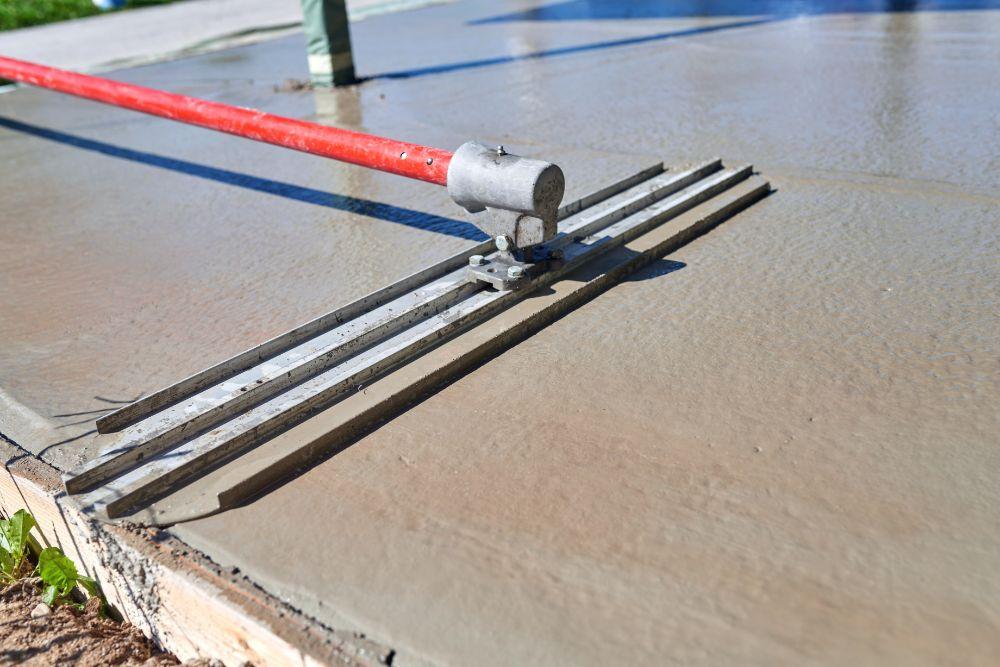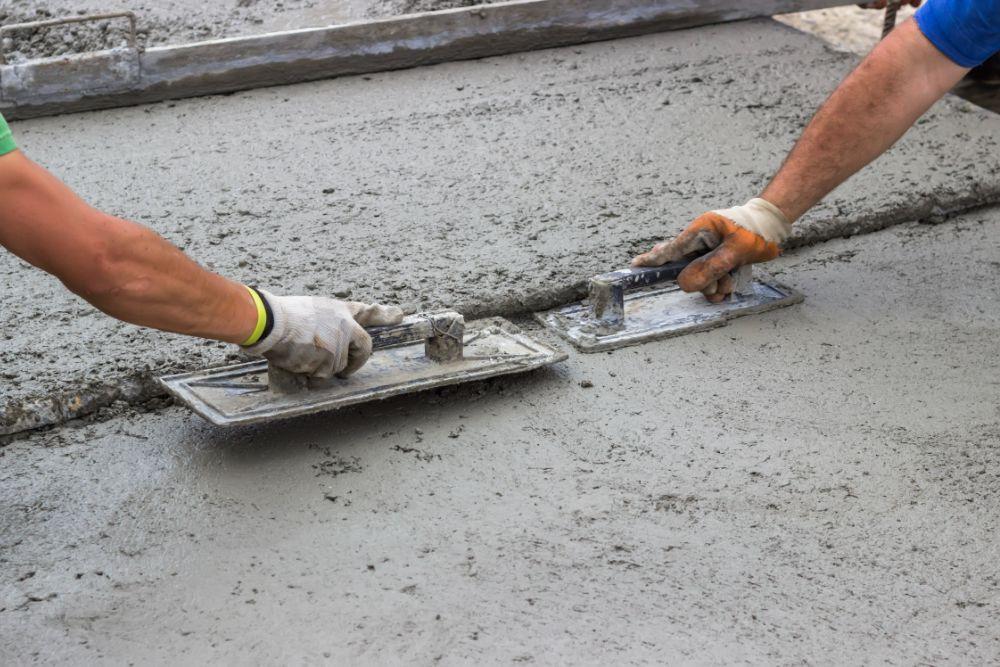Understanding Concrete Screeding
Concrete screeding ensures a level and smooth surface in construction. This process involves two main steps: using a screed tool to flatten concrete and applying a specific type of screed mix.
Definition of Screeding
A Screed Level refers to a flat board or tool used to level wet concrete. Workers pull this tool across the top of concrete forms. The action of screeding removes excess material, filling in gaps and creating a smooth, flat surface. It is a crucial step in achieving a solid, even base for floors, pavements, or foundations.
Types of Screed
There are various screed types, each with specific properties. Traditional screed mixes cement, sand, and water, providing a sturdy layer for flooring. More modern types can include compounds that allow for quicker drying times or added strength. Some screeds also incorporate fibers or polymers for enhanced durability.
Essential Screeding Tools
The right tools are critical for leveling concrete correctly. These include straight edges for evenness, trowels for smoothness, and power tools for efficiency.
Screed Levels and Straight Edges
For a level surface, workers need reliable screed levels. They use aluminum or steel straight edges to cut across laid concrete, ensuring it’s flat. Spirit levels attach to these tools to check evenness along the way.

A Straight Edge – in this case a board – is used for leveling – there are more sophisticated tools however, that are designed specifically for leveling concrete
Trowels and Floats
A trowel is essential for final surface smoothing. Workers choose from various sizes to suit the job. A bull float follows screeding, helping to compact and smooth the concrete before it sets.

A Bull Float is Used as Part of the Leveling Process
Power Screeds and Vibratory Tools
For larger areas, a power screed speeds up the process. These tools vibrate to level and compact concrete more effectively than manual methods. Workers often use a laser screed for precision and speed, especially on commercial jobs. Vibratory rollers assist in compaction, reducing air pockets and potential weaknesses in the slab.

Hand Trowels are Also Used as Part of the Concrete Leveling Process
Preparation for Screeding Concrete
The right foundation and mix impact the success of screeding concrete. Quality materials and proper site setup lead to a smooth surface.
Site Preparation
They must clear the space where concrete will lay. They remove debris, grass, and loose soil. Then they level the ground and ensure firm compaction. Guides or rails must be set to the desired height to aid in leveling.
Material
They get the correct mix of cement, sand, and aggregate. Quantity depends on the project size. They choose quality Portland cement for better results. They ensure a sufficient quantity of clean water for mixing. Wet concrete must have the right flow, not too stiff and not too runny. They adjust with materials as needed for the perfect consistency.
Execution of Screeding Process
The execution of screeding creates a level surface by removing excess concrete, ensuring durability and levelness through established techniques.
Pouring the Concrete
First, workers pour concrete over the area to set the stage for screeding. They ensure the mix spreads evenly to avoid high or low spots. Careful pouring sets the foundation for a strong, level floor. Key is to pour the mix just up to the top of the forms.
Using the Screed Level
Next, the crew takes a screed board to strike off the excess concrete. They use a back-and-forth sawing motion with the screed to level the mix. The process requires firm pressure and a steady hand to ensure levelness from end to end.
Leveling and Smoothing Techniques
After screeding, they must float the surface. They use a bull float to press down aggregate and bring cream to the surface for a smooth finish. Troweling follows, which involves using a steel trowel in a sweeping motion for additional smoothness. It’s vital for a compact and resilient concrete surface. More about Floating in a minute…
The Many Different Ways to “Screed” Concrete (Hand Screeds, Using Vibration Methods, and even Lasers)
Finishing and Protecting the Concrete Surface
After screeding, the concrete surface needs further work to ensure a durable and quality finish. This involves precise steps to level, cure, and shield the concrete from harm.
Floating and Tamping
Workers use floats to smooth the concrete and tamps to compact it right after screeding. They remove any high spots and fill in low areas, promoting a level and uniform surface. Proper floating helps to merge the aggregate with the mortar, giving the concrete adequate strength and a smooth finish.
- Tools: They often use a bull float for larger areas and hand floats for edges or smaller spaces.
- Technique: Always move the float in a sweeping motion; never let it rest in one place to avoid divots.
Curing and Protecting
Curing is vital to concrete strength and moisture retention. It should begin as soon as the surface can resist marring. Curing involves keeping the concrete damp to prevent too quick drying, which can lead to cracks.
- Methods: Workers often use wet coverings or plastic sheets.
- Time Frame: They maintain moisture for at least seven days in temperatures above 40 degrees Fahrenheit.
Specialized Screeding Applications
When screeding, some projects need special care such as floors with heat systems or floors that get different coatings for strength and resilience.
Screeding Over Underfloor Heating
Laying screed over underfloor heating requires precision to ensure heating pipes or cables do not get damaged. The process involves pouring screed to cover the heating system and provide a flat surface for the final floor finish. For these types of jobs, floating screed is common because it allows for insulation and creates a gap between the screed and subfloor. This method makes sure of even heat distribution and prevents cracking.
Working with Different Subfloors
The choice of screed and its application method varies with the type of subfloor. Bonded screed sticks directly to the base, ideal for strong and stable floors. For a subfloor that can’t bond with the screed, an unbonded screed uses a layer of polythene to separate the screed from the subfloor. Floating screed, typically used with underfloor heating, involves laying screed on top of insulation material.
Utilizing Screed Additives
Screed additives enhance screed properties. Polymer additives increase the screed’s strength and flexibility, resisting cracks and damage. These additives allow for a thinner application of the commonly used self-leveling screed. Self-leveling screeds are perfect for creating a flat surface for tiles or other floorings in both new builds and renovations.
Common Screeding Challenges and Solutions
When laying screed flooring, contractors face issues like cracks, uneven surfaces, and stability. These problems require specific fixes to ensure a level surface for any project.
Preventing and Repairing Cracks
Cracks in screed arise from poor compaction, drying shrinkage, or excess water in the mix. To prevent them, contractors must ensure a proper mix ratio and compact the screed correctly during installation. A mix that is too dry or too wet can lead to trouble. If cracks appear, they can fill them with a suitable repair compound designed for screed flooring. It’s crucial to address cracks early to avoid more damage.
Managing Unevenness and Stability Issues
Uneven screed causes trip hazards and can affect the finish of the final floor covering. Contractors can prevent uneven surfaces by using precise leveling tools during the screed installation. For existing unevenness, grinding down high spots and filling low areas with leveling compounds can restore stability. Regular checks during installation keep the surface level and stable.
Incorporating Screed for Renovations
Renovations often uncover issues with old masonry or existing substrates that may not be stable enough for new screed. Contractors need to assess the substrate carefully and repair any damage before laying new screed. They also should use a bonding agent to ensure good adhesion between the old and new screed layers. In renovations, the screed must mesh seamlessly with the existing structure to ensure a smooth, reliable finish.
Screeding for Different Use-Cases
Screed creates level surfaces and readies floors for final touches. Correct screed application differs for each setting.
Residential Flooring Applications
For residential projects, screed serves as a flat base for the final floor. It’s important to choose the right type of screed floor which often includes an underlayment to support wood or tile installations. Typically, a thickness of about 4-6 centimeters ensures a solid foundation without wasting materials.
- Materials: Wood or tile.
- Process: Evenly spread the screed mix, then level.
- Key Point: Aim for a consistent, durable surface.
Commercial and Industrial Projects
In buildings like warehouses or offices, the screed must handle heavy traffic. Commercial screed applications often involve a thicker layer and might include reinforced aggregate to improve durability. For these projects, accurate leveling is critical to prevent damage under rigorous use.
- Demands: High durability, withstand heavy use.
- Techniques: Use of heavy-duty screeds with additives.
- Consideration: Surface must support heavy loads and frequent traffic.
Outdoor Spaces like Driveways and Patios
Outdoor screeding for driveways and patios faces elements like rain and temperature changes. The choice of screed and pavers must account for outdoor conditions. A well-leveled screed helps avoid water pooling and extends the life of the surface.
- Challenges: Weather influences, varying loads.
- Solutions: Weather-resistant screeds, proper drainage slope.
- Result: Long-lasting driveways and patio spaces.
Frequently Asked Questions
What is the correct technique to level a concrete floor with screed?
The correct technique involves pouring the concrete, spreading it, and then using the screed in a sawing motion across guides. This method pushes excess concrete and fills in gaps, creating a level floor.
Can you explain the process for screeding concrete against a wall?
When screeding against a wall, one must ensure a true edge to guide the screed. They apply concrete near the wall, position the screed flush with the wall, and then pull it across the concrete to achieve a level edge.
What steps are involved in making a concrete screed board?
To make a screed board, they cut a straight and level piece of lumber or metal to the desired length. It should reach across the work area with ends shaped to glide over guides.